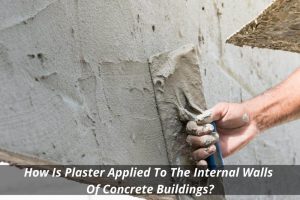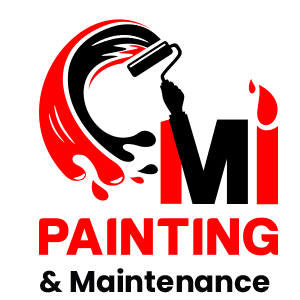How Is Plaster Applied To The Internal Walls Of Concrete Buildings?

Plastering is a common material used to coat the interior surfaces of buildings such as house painting or office spaces. The exterior surface of the building is often covered with stucco or brickwork. Sydney painters used plaster inside buildings to cover the walls and ceilings.
Plaster is a mixture of clay, sand, water, and lime (calcium hydroxide). When mixed together, these ingredients form a paste that dries into a solid mass. This substance is then applied to the wall using various methods.
There are several ways to apply plaster to the walls of a building. One method involves mixing the dry components of the plaster at the job site. Another option is to mix the dry components of the mortar at the job site before applying them to the wall. Still another way is to pre-mix the dry components of the plasters at the factory and ship them directly to the job site.
To create an effective finish on the plaster, it must be properly prepared for application. Before any plaster is applied to a wall, it should first be dampened with water.
In some cases, a “wet” primer can also be added to the plaster prior to its application. Once the wet plaster has been applied to the wall, it must wait until it is completely dry. Plastering is usually completed in one day.
The number of factors determines whether or not the plaster has dried thoroughly by the next morning. Some experts believe that the moisture level in the room will affect how long it takes for the plaster to dry. If there is too much humidity in the room, the surface may still be damp when the crew returns from the job the following morning. To prevent this condition, they suggest covering the floor with plastic sheeting while the plaster drying process continues.
After the plaster has fully cured, it must be painted. Doing so gives the building a finished look. There are many different types of paints available. Each type comes with specific benefits and drawbacks.
Choosing a particular type of paint depends largely on what kind of appearance the painter desires. For example, latex paint is known for being easy to clean up after finishing the job. However, it does have a short life span compared to oil-based paints.
Other popular options include acrylics, enamel, epoxy, and urethane. They each offer their own unique advantages.
In addition to choosing which type of paint to use, the painter must decide where he or she wants to place the colour. This decision depends on the overall design scheme of the space. It might require consulting with other designers and/or architects to make sure that all areas are properly planned out.
Painters are trained professionals who are responsible for ensuring that all aspects of home improvement projects go smoothly. As part of this responsibility, they are required to ensure that everything runs as planned. From making sure that the right materials are used to planning out every aspect of the job, they must do it all. Otherwise, they run the risk of damaging the property and even costing owners thousands of dollars in repairs.
Is there a difference between dry and wet plasters?
Wet plaster is simply a mixture of the two main ingredients: gypsum and cement plaster. Dry plasters contain only gypsum; no cement is included. The reason why the two kinds are called “dry” and “wet’ plasters may seem confusing.
After all, both of them are used when plastering the interior surfaces of a house. However, there are significant differences. For instance, the type of plaster used affects the texture, hardness, and durability of the finished product.
Generally speaking, dry plasters are the most common type of plaster used today. They tend to adhere better to new surfaces (such as newly laid plywood) than wet plasters do. Because of this characteristic, dry plasters can also be used to fill cracks in brickwork and stucco.
On the other hand, because they are less durable, dry plasters cannot be used to cover old walls or floors. In fact, if you notice any signs of cracking on dry plaster over time, it’s best to replace it before any serious damage occurs.
Wet plasters are more expensive than dry ones. But they provide superior insulation properties because they create an air pocket around the material. This creates a barrier against heat transfer through the wall. Additionally, because they allow water vapour to escape easily, wet plasters also reduce condensation inside the walls.
However, they don’t last as long as dry plasters. Because they contain only gypsum, they need to be re-applied several times throughout the year. Furthermore, they are not recommended for exterior use. This is because once they get wet, they start to deteriorate very quickly.
What is the lifespan of a plasterboard door frame?
The lifespan of a plasterboard doorway will vary depending on how it was installed. If your doors were hung using screws rather than nails, then they will probably last longer than if they were nailed into place.
If you want to extend the lifespan of the frame, you should try to avoid having to frequently open and close the door. This means removing hooks from the hinges whenever possible. Also, never leave your doors wide open, especially at night. This can cause moisture buildup which can lead to rot and mould growth.
If you want to make your doors look presentable, you could opt for an oil finish. It adds a protective layer to the surface and makes the wood appear softer and smoother. This can help prevent mould formation over time. You would need to apply the oil twice annually, however, and test each application with a sample piece of timber.
What are some common mistakes with applying plaster?
Applying a dry plaster to a wet wood floor is one of the most common mistakes that people make, so it is important to know what causes these problems. First off, remember that it is always safer to begin by covering the entire floor area first.
Then, after the room has dried completely, you can apply the remaining area. When applying plaster to a wooden floor, take care to ensure that the boards are flat and level underneath the coating. This is particularly true if you plan to use a roller applicator.
Make sure the roller is level before rolling out the plaster. If you see bumps or uneven areas, you should smooth them out before continuing.
Another mistake that many people make is not allowing enough time for the drying process. Most plasterers advise waiting for a minimum of 24 hours between the initial application of the plaster and its final setting. The reason for this is simple: during this period, the plaster will continue to absorb moisture from the atmosphere, leaving behind traces of dampness. This may mean that when you finally install the finished flooring, you will have to remove the tiles or vinyl flooring to find evidence of mould, mildew, and bacteria.
Another major problem that is caused by improper drying of a floor is warping. This happens when the boards expand and contract unevenly as they dry. To avoid warpage, make sure that you keep your floors warm during the curing process. Warm temperatures will stabilize the expansion rate, making the floors much more stable.
What type of cement mix is used to make the concrete walls?
Concrete walls are usually made using Portland cement, but there are other types of cement available. Some are blended with different materials, such as sand, gravel and clay, to achieve certain properties. For example, high-early strength concrete uses a mixture of Portland cement, sand and crushed stone. A low-strength concrete mixes only Portland cement into a powder form, while a standard concrete mix contains Portland cement, water and aggregates (sand, gravel and/or recycled metal).
A professional plasterer will be able to tell you how long it takes concrete to harden. However, in general, it is best to wait until the concrete reaches 90% of its maximum compressive strength for safe handling. This stage occurs approximately two weeks after mixing.
Should I add any additional ingredients to my concrete mix?
One of the most common questions asked by homeowners looking to renovate their homes is whether they should include additional ingredients in their concrete mix. While adding additives to concrete can improve its quality of painting, the risk of health hazards rises along with the cost.
There are several reasons why including additives in concrete mixtures might be unsafe. One of the most obvious risks comes from the fact that these chemicals may leach into the surrounding soil, contaminating it.
Another danger stems from the potential toxicity of some of these substances. Finally, you also run the risk of inhaling fumes coming from the chemical additives. The risk of exposure increases at higher concentrations and longer contact times.
What kind of paint is used to coat the inside of the building?
The interior walls of residential painting buildings are typically covered with gypsum plaster and painted with an exterior oil-based paint. In commercial buildings, however, the walls are often coated with epoxy resin. Epoxy paints contain no volatile organic compounds (VOCs), which means that they do not release harmful vapours into the air. They also offer greater resistance to cracking and peeling.
What should I look for in a good painter?
To hire a professional painter, you might want to consider asking friends, family members, neighbours and even former clients about previous experiences with them. You can also check their previous excellent work and you can also ask the painter to provide references from satisfied customers for highly recommended. Be aware that you cannot always trust word-of-mouth recommendations, so it’s important to check out the reputation of any company before hiring them.
Painting contractors have years of experience and also have a number of certifications, such as the National Council of Exterior Painters Certification, Home Improvement Contractors Registration Board and the Better Business Bureau. These organizations ensure that contractors comply with safety standards and follow proper practices. Ask if the contractor has any special training or certification.
